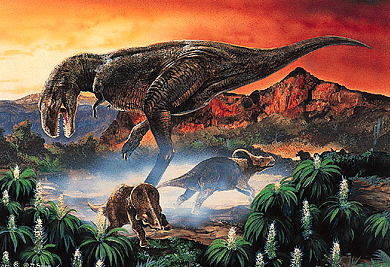July 11-17, 2013, Current Events Lesson Plan
Current Event:
A fossilized tooth from a Tyrannosaurus rex found in the tailbone of a plant-eating dinosaur has provided convincing evidence that the “tyrant lizard king” was, in fact, a fearsome predator–not a scavenger, as some scientists had speculated. Scientists discovered the broken tooth and tailbone at a famous fossil site in Montana. The scientists concluded that the duckbilled dinosaur had survived its encounter with the T. rex because the area around the tooth had healed. Thus, the plant eater was not a dead animal that the T. rex had scavenged. Most scientists believed that T. rex was an active hunter that could run for short distances and may have waited in hiding for its prey to come closer. The remains found in the stomach of other T. rex fossils as well as the dinosaur’s fearsome bite and body plan all suggested the beast attacked and ate prey. But some scientists had a different view. They felt that T. rex’s body plan suggested the creature may have been too slow or too clumsy to hunt effectively. Instead, they speculated that the dinosaur may have been a scavenger that fed on dead animals.

A Tyrannosaurus attacks two small plant-eating dinosaurs in an illustration showing the meat eater as a fast, active creature. Tyrannosaurus's skin is tight and scaly, making its body look athletic and limber. (c) Jan Sovak
Objective:
Dinosaurs were prehistoric reptiles that ruled Earth for about 160 million years. These animals died out tens of millions of years ago. Tyrannosaurus was a large, meat-eating dinosaur that lived about 68 million to 65 million years ago in what is now western North America. The name Tyrannosaurus means tyrant lizard. Tyrannosaurus got its name because scientists thought that such a huge beast must have ruled over all other animals, killing whatever and whenever it chose. The scientific name for this species is Tyrannosaurus rex. Tyrannosaurus was one of the largest meat-eating dinosaurs. It was about 40 feet (12 meters) long, stood about 12 feet (3.7 meters) high at the hips, and weighed about 7 tons (6.3 metric tons). The dinosaur’s strong jaws had sharp teeth that were about 6 inches (15 centimeters) long. The animal’s short, flexible neck and powerful body allowed Tyrannosaurus to use its monstrous jaws to rip off large chunks of flesh. The Behind the Headlines news stories and related World Book articles explore the Tyrannosaurus and other dinosaurs.
Words to know:
Discussion Topics:
1. Ask your students to name some types of dinosaurs. (Students might name the Apatosaurus (formerly called Brontosaurus); Brachiosaurus; Stegosaurus; Triceratops; Velociraptor.)
2. Ask your students why they think people are fascinated with dinosaurs, particularly the T. rex.
3. Have your student look at the “Early view of Tyrannosaurus rex” and “Modern illustration of Tyrannosaurus rex” illustrations in World Book’s Tyrannosaurus article. Using these pictures as a guide, ask your students how scientists’ understanding of T. rex has changed over the years.
4. Ask your students to use the World Book’s Timelines feature to create a timeline of dinosaur discoveries. (Students may wish to use the Dinosaur discoveries section of the Dinosaur article for help.)


